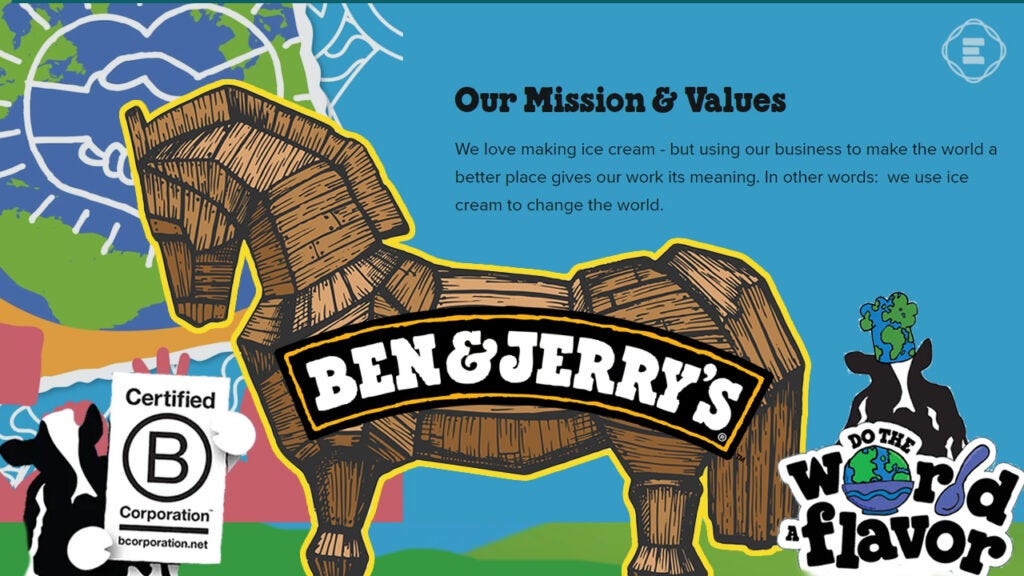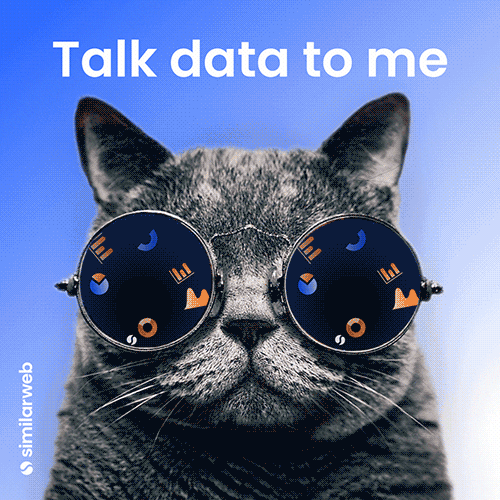🐢 Hidden Opportunity: Sustainability Reports in Marketing
With examples from Patagonia, IKEA and Ben & Jerry's: Why and how companies can successfully use their sustainability strategy and reports in marketing.
Anyone who deals with sustainability in a company knows:
There is a lot of reporting to come.
From January 1, 2024, the European Sustainability Reporting Standards (ESRS) will become mandatory for around 50,000 companies in the EU.
Hi 👋 I’m Florian Schleicher. This is the FutureStrategies newsletter of FUTURES. Thank you so much for reading along 💚 If you want to learn strategic marketing from me, then my Simple & Sustainable Marketing Academy is the perfect fit for you.
This change also affects companies with more than 250 employees, a balance sheet total of more than 20 million euros, or net sales of more than 40 million euros. Large companies that were previously not required to report will have to report from 2025, while smaller and medium-sized capital market-oriented companies as well as certain credit institutions and insurance companies will be included from 2026, with an opt-out option until 2028.
In short: from 2025, many companies will have to prepare and publish detailed annual sustainability reports. These reports must contain comprehensive information on environmental, social, and governance (ESG) issues and document the progress and impact of their sustainable business practices.
An important legal concession to our planet and the needs of consumers:
51% of Gen Z always research a brand’s stance on CSR before buying.
While many consumers and journalists are already eagerly awaiting these reports, their comparability, and progress, this means one thing for sustainability departments:
It's a lot of work.
I see time and again that companies are overwhelmed and overloaded with these new tasks, which is why today we are taking a closer look at sustainability reports and their potential in marketing:
1️⃣ The importance of sustainability reports for modern marketing
2️⃣ The 4 biggest benefits of active marketing on sustainability reports
3️⃣ Communicating successfully like Patagonia, Ben & Jerry's and IKEA
4️⃣ Using sustainability reports effectively in marketing
1️⃣ The importance of sustainability reports for modern marketing
For millennials and Generation Z in particular, sustainability and social responsibility are becoming increasingly important - they want to align their purchasing behavior with their beliefs and values.
45% of Gen Z say they would trust a brand more if they were honest about a sustainability challenge with their product.
This is why more and more brands are communicating this and want to stand out from the competition and tap into new customer segments through creative and authentic communication of their sustainability efforts.
When this type of marketing is done authentically and seriously, I call it green marketing. Falsely claiming to be sustainable is greenwashing.
Until now, it was comparatively easy to engage in greenwashing, but with standardized sustainability reports, companies are becoming transparent.
In the mandatory reports, companies must disclose their goals, progress, and impact on the environment, society, and the economy. The focus is on business practices that meet the needs of today's generation without compromising the opportunities of future generations.
However, this does not only apply to the EU, as we are also seeing more and more companies around the world publishing sustainability reports:
“Because of pressure from a growing number of ESG investors, more public companies have begun to publish what are known in financial circles as Sustainability, Corporate Responsibility or Integrated Reports. These go beyond financial reports to disclose the organization’s vision and practices related to the concerns of ESG investors—primarily the environment, human capital management and ethics.”
2️⃣ The 4 biggest benefits of active marketing on sustainability reports
Sustainability reports are therefore no longer a fleeting trend - they are becoming a strategic tool for companies. Because they address legal necessities and growing consumer expectations.
Here is my own top 4 list of benefits for brands when they actively communicate around their sustainability reports:
🤩 Convince Consumers
Sustainability is at the top of the list for consumers. A study by Kantar found that 79% of consumers want to buy environmentally friendly products. However, most customers have difficulty recognizing which products meet their criteria. Sustainability reports allow companies to provide consistent facts to let customers know what specific goals they are pursuing and how their actions have a positive impact on the environment and the community.
“People don’t buy what you do; they buy why you do it.
And what you do simply proves what you believe.”Simon Sinek
By actively communicating, we create more trust with consumers and position our company as a brand that cares about people and their impact on the world.
👷♂️ Improve talent acquisition and employee retention
Highlighting a commitment to diversity, equality, and inclusion makes companies a more attractive employer. This helps to attract top talent and retain employees and is therefore essential for corporate success.
🚧 Improve risk mitigation
Sustainability reporting requires companies to assess business operations and consider long-term viability. We must therefore regularly reflect on potential risks and plan how to overcome these challenges to strengthen our company's resilience.
💰 Attracting potential investors
Attracting customers, retaining talent, managing risk, and ensuring compliance all help to position companies as a sound investment. Thus, actively embedding sustainability reports also helps to establish sources of funding for listed companies.
Very often, sustainability and green marketing are still seen as additional tasks with no direct value.
However, McKinsey and many other expert organizations now assume that sustainable products and services will create a market worth more than 12 trillion dollars in annual sales by 2030.
“ESG isn't about philanthropy or PR. It's about long-term value creation.”
Luke Joyce, Kyyte
Some forward-looking companies have already recognized this potential and use sustainability reports in their marketing:
3️⃣ Communicating successfully like Patagonia, Ben & Jerry's and IKEA
Some brands are already doing a great job of using their ESG reports in marketing to reach target groups and build loyalty:
👕 Patagonia
I have already written about Patagonia's pioneering role in sustainability and green marketing.
The company also makes intensive use of its sustainability reports to highlight its environmental commitments in all its communication channels.
The reports are communicated prominently on the website, social media, and PR campaigns with a particular focus on transparency and authenticity. Social media posts, for example, often contain visual elements such as infographics that clearly illustrate the most important facts and figures from the report. In addition, short videos are shared in which employees and managers explain the most important results and future goals.
Their open communication, which also presents goals that have not yet been achieved, strengthens customer trust and promotes a loyal following that identifies with the company's values
CSRD Reporting: Preparing for Mandatory ESG Disclosure Deadlines
🇸🇪 IKEA
IKEA uses its sustainability reports to reinforce its brand image as a responsible and environmentally friendly home furnishing store. They do this by telling stories about their sustainability efforts, such as initiatives to reduce their environmental footprint and projects to support renewable energy.
By 2030, the company plans for every product containing plastic to be made from renewable or recycled material. And in general, IKEA wants to reduce its CO2 footprint by 70% by 2030.
In their report, they back this up with figures:
“For example, 85% of one their popular plastic bags is now made from renewable materials. And they phased out all single-use plastics from one product range in 2020. It's these specific facts that turn their bold claim into green marketing and not greenwashing.”
This is green marketing lived out in practice: setting goals around sustainability and then communicating about it, in which they prove that they are working on it.
All this information is shared in marketing campaigns, on the website, and on social media. By regularly communicating progress and goals in the area of sustainability, IKEA plans to appeal to particularly environmentally conscious consumers and strengthen their customer loyalty.
🍦 Ben & Jerry’s
Ben & Jerry's integrates sustainability reporting into a variety of marketing activities, such as blog posts, its website, and social media campaigns, to share stories about the positive impact of their sustainability efforts. In doing so, they are driven by a strong mission:
“A business that focuses only on maximising profits is unsustainable. For a business to be relevant it has to respond to the world we live in. We don’t know better than the others or have all the answers, but we know we have to do everything we can to build a better, just, and sustainable world.”
Anuradha Mittal, Board Chair Ben & Jerry’s
By telling these stories and showing the people behind the figures, Ben & Jerry's creates an authentic connection with its customers and strengthens its position as a socially responsible brand.
The ice cream producer's approach is that of a Trojan horse - first and foremost, people buy good ice cream - the fact that it is also sustainable is a bonus:
And, like Patagonia, they show that sustainability must first be integrated into the strategy before it can be talked about credibly.
4️⃣ Using sustainability reports effectively in marketing
What does this mean for companies that are in the process of writing their first sustainability reports or are preparing to do so and want to use this in their marketing?
We can use the hard work that goes into creating sustainability reports.
However, we need to prepare data and facts in an exciting, authentic, and attractive way so that they are well received.
Here is my checklist on how this can be done:
1 ✅ Finding the stories behind statistics
What's behind the figures in the ESG report? Storytelling is one of the most important arts in contemporary marketing.
Perhaps there is data on waste reduction, for example - how did that come about? Are there statistics on community initiatives? How have partnerships improved people's lives? Are there specific people who can bring these "dry" facts to life? Many reports start with statements from the CEO or CFO - can these be turned into successful short videos?
This also makes our reports emotionally tangible.
Nowadays, marketing has to do one thing above all: entertain.
And unfortunately, many companies still struggle with this.
2 ✅ Transform ESG reports into authentic content
I have already written here several times about the importance of authentic content in marketing.
3 out of 10 millennials unfollow brands on social media because their content seems "fake".
The same applies to the communication of ESG reports.
Our ESG content therefore needs a simple, uncomplicated, human-oriented, and self-critical translation into green marketing. We must use examples that our target groups understand and can identify with.
So this is about questions such as:
Are there challenges that still need to be overcome? Are there people behind the individual topics and projects? Who can communicate our strategy authentically?
By giving our target group real insights into your sustainability journey, we create long-term trust in our brand and inspire action.
I think the CEO of Kraft Heinz is already doing a lot of things right, even if there is still room for improvement:
3 ✅ Sharing our (sustainability) vision
Sustainability must first be anchored in our general strategy and thus our vision.
A good vision combines a desirable future with our values and the purpose of our company. A good strategy that is driven by a clear, bold, and emotional vision creates a solution and thus a competitive advantage.
And that is why it must also include sustainability. Because if our vision is only profit, the whole company will only move in that direction.
However, if we also consider people and the planet in our vision, then we can proudly communicate our vision to the outside world - preferably in an authentic way.
Patagonia does this brilliantly when they write:
“We protect our home planet. We do this by building the best product, providing the best service and constantly improving everything we do.
The best product is useful, versatile, long-lasting, repairable and recyclable. Our ideal is to make products that give back to the Earth as much as they take.”
This is a vision that is easy to share and may inspire others.
Kraft Heinz also does this excellently.
“…because our value “We do the right thing” is part of our people’s DNA, we do it with honesty and integrity. We are working hard each day to make life delicious.”
Miguel Patricio, CEO The Kraft Heinz Company
4 ✅ Inspire your target group to take action
The best companies not only share what they are doing well in terms of sustainability but also activate and inspire their target groups to live and act more sustainably themselves.
By turning numbers into concrete examples and tips, companies can not only achieve their own environmental goals but also spark a broader movement for sustainable action.
A good example of this is Trilogy Fashion, a product from SAP.
This can compare the ecological footprint of a pair of trousers purchased on the re-commerce platform with that of a new item of clothing. Giving customers "eco-credits" when they buy clothes from their re-commerce marketplace or choose sustainable shipping options, creates greater customer loyalty. And the use of this technology underlines the seriousness of the company's sustainability efforts.
Incidentally, this is not only relevant for B2C but also for B2B companies:
73% of B2B decision-makers plan to end their collaboration with non-sustainable companies.
5 ✅ Integration in employee communication
We know that sustainability plays a key role in attracting the best talent to your company.
One in three 18- to 24-year-olds have turned down a job offer because the company's environmental commitments did not align with their own.
This underlines the growing importance of corporate responsibility and sustainability in the eyes of the younger generation and therefore the importance of communicating our hard facts from the ESG report.
But we can also use sustainability reports in our internal communications to build loyalty among our employees and show them authentically what we do.
And even more importantly, we can use internal know-how to improve our efforts. If employees understand what the current challenges around sustainability are, they can get involved and find new solutions in a dialog.
💚 Conclusion on the use of sustainability reports in marketing
Do good and talk about it. That is the art of good green marketing.
And it starts with doing good. In other words, to address the issue of sustainability authentically, courageously, and strategically.
The new guidelines such as ESG Reporting, ESRS, and CSRD are now driving this approach and at the same time offer great potential for green marketing.
Sustainability reporting goes beyond mere compliance - it is a transformative strategy that drives companies toward growth, resilience, and positive social impact.
When sustainability departments talk to marketing managers and communicate facts and progress together, the result is added value for everyone.
For people.
For profit.
And for our planet.
The world needs more of this.
Thanks for reading!
PS: You can also read this Posting in German.







